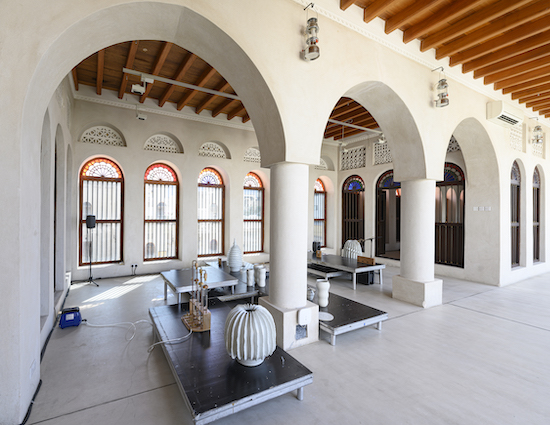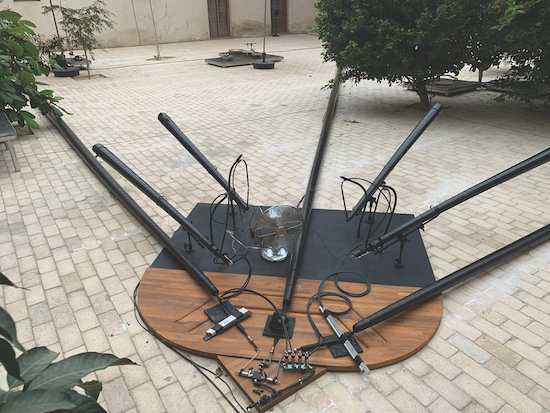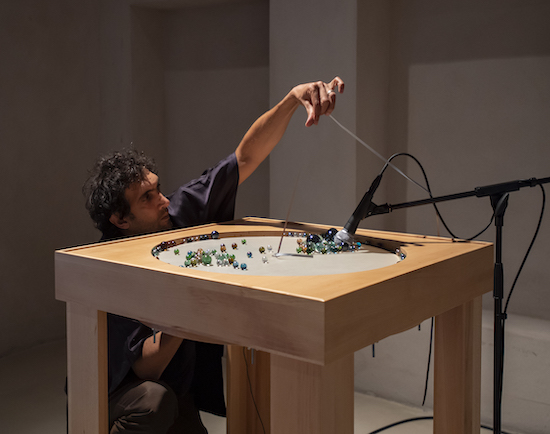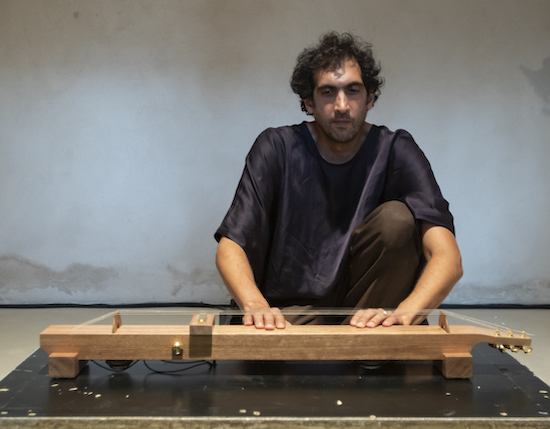Tarek Atoui performing at the opening of Tarek Atoui: Cycles in 11. Sharjah Art Foundation, 2020
Throughout 2020 we have seen spaces and projects keen to address the gaps between themselves and audiences, to shift works onto online platforms with assertions of increased access and international reach. These actions became a necessity in a pandemic, replacing the known conditions of attending exhibitions, site-specific work, and performances. Talking to Tarek Atoui about how his work for Cycles in 11 can be encountered, we discussed the limitations of the screen and the potentials that this in turn creates for artists to defend the conditions in which their work is encountered in. That timelines are malleable, that projects can be extended to enable the work to live as intended.
Watching a video recording of a collaborative rooftop performance of Atoui’s for Cycles in 11 you could observe the eyes of the audience moving in a different direction to the camera, watching the performance and the ways in which those involved listened to and made space for each other, creating opportunities for different approaches to sonics to build and occupy public space. As a remote listener, I was reminded of a Pauline Oliveros’ exercise from her book, Deep Listening: A Composers Sound Practice, in which she states: “With each breath I send sound and receive sound”. A universal continuum to bring all work closer in uncertain times.
Tarek Atoui has worked extensively with Sharjah Art Foundation since 2010 focusing on workshops and performances alongside the presentation of projects, including: Below 160 (2012), a work that asked students at Sharjah’s Al Amal School for the Deaf to interpret sound with senses other than hearing, and WITHIN (2013), a sound composition where ten international musicians came to work with local musicians performing a series of interrelated movements on rooftops, roundabouts alongside the heritage areas and squares in the city. Cycles in 11 is an exhibition that further focusses Atoui’s engagement with site and the creation of frameworks for collaboration, education and outreach.
Cycles in 11 brings together practices, workshops and collaborations made over several years, how has the exhibition taken shape for you?
It’s a decade of education and evolution, the development, maturation of my ideas on education, of my ways of conducting and thinking, education within an institution or in general. It’s also a decade of working in Sharjah and the region, looking at the state of the region and where it stands in the world. Especially in the MENASA areas of Southeast Asia, North Africa, Middle East. It’s a combination of concerns that took shape, thanks to the architecture of Bait Al Serkal, the house where the exhibition is based. Which has this architecture of an old traditional Iraqi house, (it’s actually part of the UNESCO World Heritage). A house with long spaces and corridors, and a central courtyard which is a prominent and important area. The exhibition found itself in these long corridors and smaller rooms.
There are possibilities for certain rooms to be closed and others to be open. There are rooms that are for listening, in which compositions are installed with several instruments playing as automatons. Then there are rooms that are only open for public performances or the moments when people play in them. In these moments, the windows and the doors open. There are rooms for workshops and experimentation. Ones that open when we have school classes. The audience, as well as residents, can come and work in them. There’s another category of rooms which host workspace for residents. We have a residency program that is open and will host twelve composers from all over the world, who will come to Sharjah to work on their own projects, but also work with the content of this exhibition its instruments, its rooms and audiences.

The Ground, 2020. Courtesy of the artist and Vitamin Creative Space
We so often engage exhibition as tied to objects. Within Cycles in 11 there’s the connection of sound as an experiential, embedded within the work (and its functions) as pedagogy and sharing.
Well, what I’m going to describe to you is all intentions, because at the moment, there’s a lot of trouble implementing all this with the present conditions. We’ve extended the show, what we are striving towards now is this situation where the exhibition, gives back to the people of Sharjah. Things I started developing in Sharjah, I then carried to other places in the world, that had to interact with other cultures, other philosophies, other audiences; and are now brought back to Sharjah under another form (or in a completed way). The project WITHIN, on sound and deafness that started in Sharjah, had a six or seven-year lifespan in a multitude of countries and places from Russia to the States to Europe. Now WITHIN comes back to Sharjah with ideas on how to work with hearing and non-hearing audiences.
So it’s this incremental experience that is re-injected into the show and hopefully shared with the people from Sharjah, introducing an international audience of musicians & composers to not just to my practice, but also Sharjah and its audiences, through using my work as an entry point to access it. To establish bridges between the works of different composers and audiences, musicians, collaborators with the people who take workshops with them. The scenarios are multiple.
Something I’m very interested in also is to see how other people appropriate instruments or tools or ideas I have developed or initiated. That can be then transformed by the experience of others, whether they are deaf or hearing, amateurs or professionals. I really value all these experiences. I consider them as expertise. By making things accessible this way, you are breaking the status of what an artwork is constituted of. Because these are instruments, and they are part of my compositions and installations, they maybe have the status of an artwork (and you cannot touch them). But when you find them back in the workshop room or in the performance room, they have another status, and they navigate between these different states.
But this is all part of their life. An instrument has this potential to grow outside of its maker, outside of its original community and have a life of its own. Where it goes beyond genres and borders and levels of virtuosity. To give it a space of expression within the work, to give the possibility for instruments to reach out to other people so that this experience of other people, other people’s contact is brought back to the world and inspires future steps or inspires other people.

The Wave (detail), 2019. Courtesy of the artist and Galerie Chantal Crousel
The contact you’re talking about here is a really important one. There’s a phenomenal ability for creativity through the transformation of materials and the consideration of sound as a material itself. One that doesn’t need to be restricted or held back. I’m thinking here of the connection of your work WITHIN to deafness.
The exploration of sound from the perspective of Deaf people, highlighted a lot of its quality beyond the sonic and beyond its physical manifestation as vibration through air. You can feel it in other parts of the body or through the bones. It can become vibration through metal, or the vibration can become another source of energy. You can convert vibration into electricity and use this electricity to drive something else. You can transform this vibration into a movement (and have this movement say something else).
So it’s also about the transformation of sound into other sources of energy, mechanical or emotional. It’s like going from the super-concrete to the super-psychosomatic. Sound addresses really deep parts of our minds and being and we all perceive it differently. You see it the way we are all deaf when it comes to sound because we never grasp it.

Tarek Atoui performing at the opening of Tarek Atoui: Cycles in 11. Sharjah Art Foundation, 2020
So much of our relationship with the environment has changed this year along with our relationship with space. Important in this present time is how we focus on hospitality and on sharing and the future.
What I still stand by and defend is the necessity of us meeting together, whatever the conditions and however hard it might seem at first sight to meet. And in playing the hospitable role, you have to stay close to the artists, to the people who are involved, the ones who you invite. It’s then about sustaining the conversation and trying to imagine together other scenarios. So this in a very pragmatic, concrete way, is taking more and more time on a daily basis.
I didn’t want to move to the digital or the virtual. I still consider that it’s a shift that is not possible for everybody – especially in the case of a work like mine. I’d rather have fewer people see it in its intended conditions. And if we push it in that sense, I think the exhibition in Sharjah, for example, is an amazingly beautiful listening space (or spaces) because of this quietness and the subtlety of city, places are not loud and are not overly crowded.
It’s the same with the performances. This regulation of audiences made it more about the flow of it than the numbers. We still try to play for three hundred people, but not necessarily in one shot. Before, in an hour, three hundred people saw it, but now it’s five hours and we play it five times and fifty people see it at a time. It brings something else: another listening attitude. So these are positive things, you know.
I think for me, shifting things onto virtual platforms, in some cases it could be like a lazy answer to what our mission and task is as people who defend culture and who defend accessibility to arts and culture. Open source is half of the gesture, the other half is still about hospitality and bringing people to these platforms and spaces we create. So that’s where things are at play.
Tarek Atoui: Cycles in 11 is currently programmed to run to the 10th of April 2021 at Bait Al Serkal, Arts Square, Sharjah and is curated by Hoor Al Qasimi, President and Director of Sharjah Art Foundation


